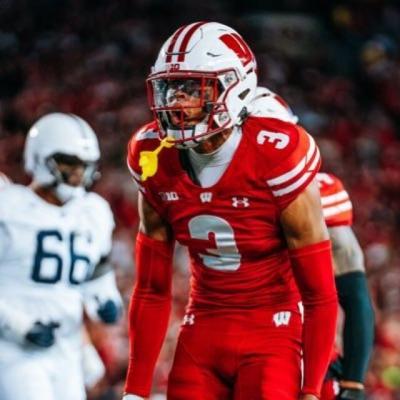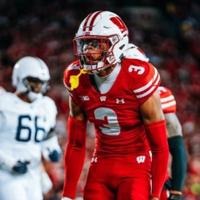
Nyzier Fourqurean
A federal appeals panel has reversed a University of Wisconsin football player’s successful challenge to NCAA eligibility rules, agreeing with the NCAA that Nyzier Fourqurean cannot use federal antitrust law to win a court order allowing him to suit up for the Badgers squad in the 2025 season.
Fourqurean, who started every game of the 2024 season as a Badgers cornerback, alleged the NCAA’s Five-Year Rule, which limits athletes to four competitive seasons within five academic years, violates Sherman Act anti-trust laws. Although Fourqurean earned a bachelor’s degree in December 2024, following two years of football at Division II Grand Valley State University and two in Madison, he wants to play a fifth season as a graduate student.
U.S. District Judge William Conley granted Fourqurean’s request for a preliminary injunction, but the NCAA challenged that ruling before the U.S. Seventh Circuit Court of Appeals. Judge Amy J. St. Eve wrote the panel’s opinion, filed July 16; Judge Joshua Kolar concurred. Judge Kenneth Ripple dissented.
According to St. Eve, Judge Conley’s ruling rested on a reading of the 2021 U.S. Supreme Court opinion NCAA v. Alston, which he said defined the NCAA’s football bowl subdivision as a market from which it excluded Fourqurean. But the panel determined Alston didn’t address market definition, meaning Fourqurean had to offer an independent market definition. And even if he did define FBS as the market, his exclusion isn’t enough to support the anticompetitive allegations, the majority said.
“The NCAA does not argue that the Five-Year Rule is necessary to produce a game in the same way as rules about the number of players on the field or playing time,” St. Eve wrote. “Rather, the NCAA makes the subtly different argument that the Five-Year Rule is necessary to produce ‘collegiate athletics’ ” in that its bylaws define amateur, student-athlete status.
The panel said the NCAA relied too heavily on that position, including by failing to offer “any argument or evidence that its member schools would disband their football teams if the NCAA eliminated this rule.” But it also noted the Sherman Act doesn’t explicitly reject any exclusionary agreements and said a key issue beyond whether Fourqurean could play is what constitutes the NCAA’s competition.
“The market realities for college sports have changed in the four years since Alston,” St. Eve Wrote. “Indeed, Fourqurean explains that he ‘would rather return to UW-Madison to play Division I football’ than declare for the NFL draft for reasons including opportunities to profit from revenue sharing and (name, image and likeness contracts) — which did not exist pre-Alston.”
NIL rules also play significant roles in litigation actively and potentially facing the NCAA and its member schools regarding revenue sharing and its impact on eligibility rules. But Fourqueran’s allegations focused on his own circumstances, per the majority, and not things like prices, market power and market structure.
“Fourqurean has made no effort to establish this theory of anticompetitive effects,” St. Eve wrote. “Fourqurean would need to show that the Five-Year Rule creates, protects or enhances the NCAA’s dominant position in the market — and thus the NCAA’s ability to depress student-athlete compensation below the competitive level — by making it more difficult for the NCAA’s existing or potential rivals to compete against the NCAA.”
The majority said Forqueran could prevail once litigation proceeds and acknowledged the rapid approach of the next college football season. It further said the NCAA’s Committee for Legislative Relief could provide the flexibility to allow Forqueran to play in the 2025-2026 season.
In his dissent, Ripple said the preliminary injunction had been appropriate because Fourqurean’s complaint “plausibly alleges a relevant market in which the NCAA has monopsony power and has engaged in anticompetitive conduct not justified by procompetitive efficiencies.”
Ripple further noted the 2025 NFL draft is long complete and Forqueran’s only chance to advance his football career is another year of NCAA eligibility, whereas “the NCAA has identified no harm it would suffer were the injunction to stand.” He further said the issue is the labor market as it affects players and not the presence of other amateur football associations, and as such the rule “plainly” has an anti-competitive effect.
“The NCAA’s Five-Year Rule decreases competition in the labor market by forcing out the market’s most experienced athletes,” Ripple wrote. “In so doing, the NCAA depresses NIL compensation by declaring ineligible the very players who would be entitled to the most lucrative financial arrangements because they have spent years developing their skills.”
Ripple further said a recent NCAA rule change allowing athletes to transfer schools without limitations “impeaches significantly the NCAA’s professed interest in academic progression within the Division I market,” while adding that “Division I teams now perform against the backdrop of a lucrative NIL industry that, in its current state, is significantly divorced from higher education. When viewed in the context of an industry drastically changed by these lucrative compensation arrangements, the notion that the NCAA protects its athletes’ amateur status appears disingenuous.”


